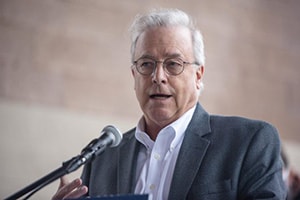By Kit Norton/VTDigger
The administrative costs of running OneCare Vermont, the company that enacts statewide health care reforms, are greater than the Medicaid savings that are credited to its efforts, according to a report issued Monday by State Auditor Doug Hoffer.
The 38-page document, which looks at the operating expenses associated with the state’s all-payer health care system, shows that from 2017 to 2019, OneCare failed to meet Medicaid financial targets by a combined $11.1 million.
During that same time frame, the state — through the Dept. of Vermont Health Access — spent $14.5 million on OneCare to run Vermont’s all-payer health care model.

State Auditor Doug Hoffer speaks at a conference last fall.
“Put simply, at this time the financial costs to run the model significantly exceed any Medicaid savings attributed to it,” Hoffer wrote in a letter accompanying the report.
Vermont’s all-payer system, created in 2016, aims to change the way hospitals and doctors are paid. Under the system, doctors are paid an annual set fee per patient rather than for each treatment or procedure. The payments are meant to encourage doctors and hospitals to invest in preventive care that will keep patients healthy.
OneCare, the accountable care organization that manages this system, brings together doctors and hospitals that agree to be responsible for the cost and quality of care of their patients. OneCare receives money from Medicaid, Medicare and private insurance companies, and funnels the money to hospitals and doctors in monthly payments.
A total of 137 medical facilities — including 13 of the state’s 14 hospitals, primary care doctors, federally funded health centers, mental health and disability agencies, nursing facilities, and home health providers — are participating in the accountable care system.
The state auditor’s office found that, based on available numbers, Vermont has spent at least $29.8 million to implement the all-payer model since the state signed its five-year agreement with the Centers for Medicare and Medicaid Services in October 2016 to implement the health care payment structure.
Eighty-four percent of that money has come from taxpayer dollars through the Medicaid contract that the Dept. of Vermont Health Access has with OneCare. The two other major payers — the Centers for Medicare and Medicaid Services and Blue Cross Blue Shield of Vermont — have not provided any administrative payments to OneCare, according to the report.
The report also recommends a financial reporting requirement in the Medicaid contract with OneCare, so the accountable care organization will provide detailed information on how money from the Vermont health access department has been allocated.
This is the second report on the all-payer model that Hoffer and his office have issued in the past 11 months.
In an interview, Hoffer said he hopes that, as the state prepares to negotiate a new five-year contract with the Centers for Medicare and Medicaid Services, it will consider the new information in the report.
“If the state proceeds as it is today, they hope to enter into a second five-year contract with CMS, and yet I think most reasonable people would agree that we don’t have sufficient information on which to base a decision as to whether that is a prudent thing to do yet,” he said.
“There’s nothing wrong with the concept of all-payer, the ACO [accountable care organization]. The question is implementation,” Hoffer said.
In a written statement, OneCare CEO Vicki Loner said her organization disagrees with the “general conclusions and perspectives” in the auditor’s report. She said the auditor report failed to account for the health care benefits the system has brought the state.
“This work takes time and investment and OneCare’s 4,000+ providers are committed to providing high-quality, effective care for Vermonters and have seen positive health outcomes as the result of their joint efforts in OneCare,” Loner said. “We are proud of the good work being done in our state and the deep commitment to tackling one of the most pressing issues of our time.”
Kevin Mullin, chair of the Green Mountain Care Board — which regulates the state’s health care system — responded to Hoffer’s report with written comments. Mullin wrote that he disagrees with the findings, and an analysis of the financial cost is not enough to assess how the all-payer system has worked.
“Look at it holistically and include the model’s impact on overall health care spending, health care quality, and population health outcomes,” Mullin said.
Mike Smith, secretary of the Agency of Human Services, also submitted a response to the report, in which he touted the success of the all-payer system.
“Predictable payments from Medicaid have added stability for Vermont’s system of care, especially considering unprecedented disruption from Covid-19,” he wrote.
Smith said the auditor’s report takes a “narrow approach to understanding the impact of the all-payer model and instead presents several totals that combine ACO savings, losses and operating costs.”
In response to these critiques, Hoffer told VTDigger that the report never says that operational costs should be used to determine the effectiveness of the all-payer system. That metric should rely on Vermont’s health outcomes.
However, he stood by the importance of taking a close look at the financials.
“If measuring the dollar impact wasn’t important, then why do they bother to measure it every year?” Hoffer said. “That’s the program measure that everybody talks about — is it shared savings or shared losses.”
“Since almost a majority of OneCare’s operating costs are paid by taxpayers, we have every right to ask the question, and that question is a simple one: Are we getting savings that are greater than our inputs?” he said.



